
Julius von Flotow; full name- Julius Christian Gottlieb Ulrich Gustav Georg Adam Ernst Friedrich von Flotow was a German military officer and a botanist specialized in lichenology and bryology.

Georg Franz Hoffmann was a German botanist and lichenologist. He was born on 13 January 1760 in Marktbreit, Germany, and died on 17 March 1826 in Moscow, Russia.
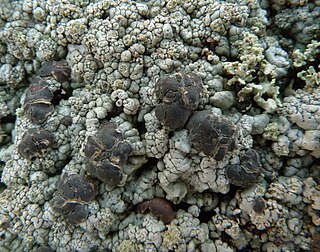
Trapeliopsis is a genus of lichenized fungi in the family Trapeliaceae. It contains 20 species. The genus was circumscribed in 1980 by Hannes Hertel and Gotthard Schneider, with Trapeliopsis wallrothii designated as the type species.
Gymnoderma is a genus of lichen-forming fungi in the family Cladoniaceae. It has three species. The genus was circumscribed by Finnish botanist William Nylander in 1860. Nylander assigned Gymnoderma coccocarpum as the type species in 1869; this species was originally collected from the Himalayas. It occurs throughout southeastern Asia.
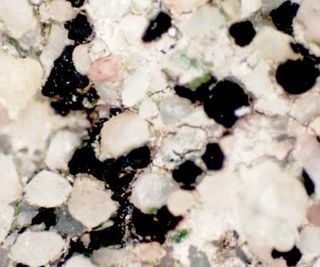
Sarcogyne is a genus of crustose lichens in the family Acarosporaceae. It was circumscribed by German botanist Julius von Flotow in 1850. A proposal has been put forth in 2021 to assign Sarcogyne clavus as the type species of the genus, "as it represents the original concept of Sarcogyne as having melanized lecideine apothecia without algae in the margin".
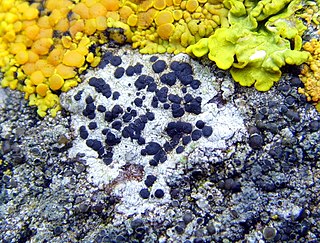
Diplotomma is a genus of lichenized fungi in the family Caliciaceae. The genus has a widespread distribution and contains about 29 species. The genus was circumscribed by Julius von Flotow in 1849. It was later wrapped into Buellia before being segregated from that genus by David Hawksworth in 1980.

Catapyrenium is a genus of lichens in the family Verrucariaceae. The genus was circumscribed by German botanist Julius von Flotow in 1850.
Gyrophthorus is a genus of lichenicolous (lichen-dwelling) fungi in the phylum Ascomycota. The relationship of this taxon to other taxa within the phylum is unknown, and it has not yet been placed with certainty into any class, order, or family. The genus was circumscribed in 1990 by Josef Hafellner and Leopoldo Sancho, with Gyrophthorus perforans assigned as the type species.

Catolechia is a genus of lichen-forming fungi in the family Rhizocarpaceae. It is a monotypic genus, containing the single species Catolechia wahlenbergii. The genus was circumscribed by German botanist Julius von Flotow in 1850. He did not assign a type species for the genus; Catolechia pulchellaA.Massal. (1852) was designated as the type by Gustav Wilhelm Körber in 1855. This species is synonymous with Catolechia wahlenbergii.

Phlyctis is a genus of lichenized fungi in the order Gyalectales, and the type genus of the family Phlyctidaceae. Members of the genus are commonly called blemished lichens.
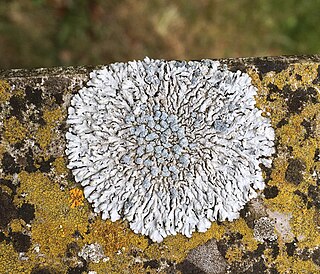
Physcia caesia, known colloquially as blue-gray rosette lichen and powder-back lichen, is a species of foliose lichenized fungus. First described by Georg Franz Hoffmann in 1784, it is common across much of Europe, North America and New Zealand, and more patchily distributed in South America, Asia, Australia and Antarctica. There are 2 subspecies: P. c. caesia and P. c. ventosa, as well as a number of distinct forms and varieties. Molecular studies suggest that the species as currently defined may be polyphyletic. It is typically pale gray shading to darker gray in the center, and grows in a small rosette, usually some 2–3 cm (0.79–1.18 in) across at maturity. It only rarely has apothecia, instead reproducing most often vegetatively via soredia, which are piled in round blue-gray mounds across the thallus's upper surface. It grows most often on rock—principally calcareous, but also basaltic and siliceous—and also occurs on bone, bark and soil. It is nitrophilic and is particularly common on substrates where birds perch.

Cladonia parasitica, commonly known as the fence-rail cladonia, fence-rail cup lichen or parasite club lichen, is a species of fruticose, cup lichen in the family Cladoniaceae. It was first described by Hoffmann in 1784 under the name Lichen parasiticus, until he reclassified it under the genus Cladonia in 1795.
Brianaria sylvicola is a species of saxicolous lichen in the family Psoraceae. It is also the type species of genus Brianaria.

Peltigera lepidophora, commonly known as the fan lichen, is a species of foliose lichen in the family Peltigeraceae. It was first described by Carl Linnaeus in his 1753 work Species Plantarum as Lichen venosus. German botanist Georg Franz Hoffmann transferred it to the genus Peltigera in 1789. P. venosa can be found in temperate and boreal regions of North America, Europe, and Asia, while occasionally being found in drier climates such as mountainous Arizona.

Umbilicaria hyperborea, commonly known as blistered rock tripe, is a species of foliose lichen in the family Umbilicariaceae. It is widely distributed in arctic and alpine regions.
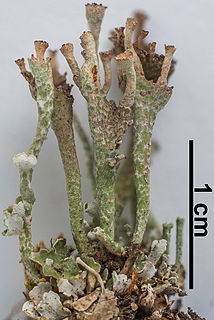
Cladonia cervicornis is a species of cup lichen in the family Cladoniaceae. It was first described by Swedish lichenologist Erik Acharius in 1799 as Lichen cervicornis. Julius von Flotow transferred it to the genus Cladonia in 1849. In North America, it is colloquially known as the ladder lichen or elk's-horn cup lichen.
Zwackhiomyces calcariae is a species of lichenicolous fungus in the family Xanthopyreniaceae. It was first formally described in 1896 by French lichenologist Camille Flagey, as Arthopyrenia calcariae. Josef Hafellner and Nikolaus Hoffmann transferred it to the genus Zwackhiomyces in 2000. The fungus is parasitic on lichens in genus Aspicilia.













